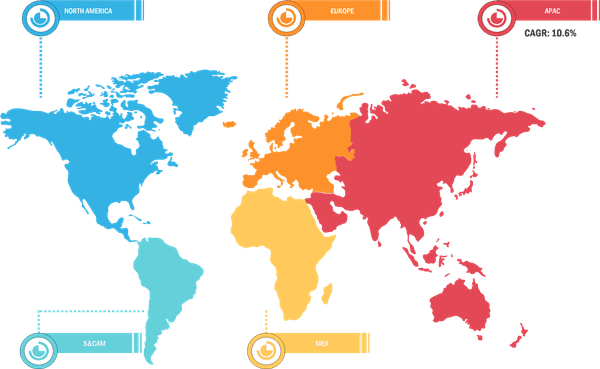Rising Demand for Organic Skincare Products
According to our latest market study, titled " Skincare Products Market Forecast to 2028 – COVID-19 Impact and Global Analysis – by Product Type (Creams and Lotions, Cleansers, Serums, and Others), Category (Organic and Conventional), End-User (Men, Women, and Others), and Distribution Channel (Supermarkets and Hypermarkets, Specialty Stores, Online Retail, and Others)," the market was valued at US$ 115,386.46 million in 2021 and is projected to reach US$ 213,363.09 million by 2028. It is expected to grow at a CAGR of 9.2% from 2021 to 2028.
Skincare products are personal care products applied directly to the skin to preserve and nurture it. These products include regular facial wash, cleansers, moisturizers, lotions, masks, serums, sunscreens, and gels that both men and women use. These skincare products are available in various categories and types, including face care, body care, bath & shower, and perfumes. Skincare products are becoming increasingly popular among men and women seeking nourished, moisturized skin. As a result, the demand for skin care products is likely to rise globally, thus contributing to the market growth. Further, the rising demand for organic skincare products is driving the skincare products market growth. The growing awareness about the health benefits of skincare products such as improved skin, protection from pollution, and others among consumers worldwide is propelling the skincare products market growth.
Skincare is an essential part of personal care. It includes everything, from correction to prevention, in the process of skincare. Makeup with skincare benefits has been prevailing in the market. Skin sensitivity and awareness about the deleterious effects of chemicals and synthetic products are fueling the growth of the organic skincare product market. A majority of the consumer base tends to buy products with the terms natural or organic associated with them. The organic skin care products market is quite dynamic in nature and has been increasing at a fast pace. Market players are consistently exploring ways to deliver innovation with new functionalities and features. For instance, in December 2020, Forrest Essential launched its natural makeup and skincare product line, which is enriched with potent natural and organic ingredients and special serum formula enhancing both lips & eyes. In January 2022, L'Oréal and Verily announced a first-of-its-kind strategic partnership to advance precision skin health. It is expected to entail two programs to better understand and characterize skin and hair aging mechanisms and inform L'Oréal's precision beauty tech strategy and product development. The usage of wrong products triggers allergic reactions. Hence, there has been an increasing focus on organic skincare products, which, in turn, will boost the skincare products market growth.
Key players operating in the global skincare products market include L'Oréal Groupe; Beiersdorf; Shiseido CO., LTD.; Procter and Gamble; Unilever; Himalaya Wellness Company; Lotus Herbals; VLCC Wellness; Avon Products; and Johnson and Johnson Services, Inc.
Impact of COVID-19 Pandemic on Skincare Products Market
Many sectors faced unprecedented challenges due to the COVID-19 outbreak. The consumer goods industries also suffered from severe disruption due to lockdowns, travel bans, border restrictions, the shutdown of manufacturing units, among other factors. However, the COVID-19 pandemic had a mixed impact on the skincare products market. Moreover, the sales of the products through online outlets escalated during the pandemic. However, due to the shortage of raw materials and laborers, a production shortfall created a demand and supply gap. The manufacturers are overcoming the demand and supply gap as they can now operate fully. Moreover, the majority of the countries are vaccinated, which is a positive sign for the global marketplace. These factors are expected to drive the skincare products market over the forecast period. Thus, the skincare products market witnessed a mixed impact of the COVID-19 pandemic.
Skincare Products Market Breakdown – by Region

Skincare Products Market Growth Report by 2028
Download Free Sample
Skincare Products Market Forecast to 2028 - COVID-19 Impact and Global Analysis By Product Type (Creams & Lotions, Cleansers, Serums, and Others), Category (Organic and Conventional), End User (Men, Women, and Others), and Distribution Channel (Supermarkets & Hypermarkets, Specialty Stores, Online Retail, and Others)
Skincare Products Market Growth Report by 2028
Download Free SampleSkincare Products Market Forecast to 2028 - COVID-19 Impact and Global Analysis By Product Type (Creams & Lotions, Cleansers, Serums, and Others), Category (Organic and Conventional), End User (Men, Women, and Others), and Distribution Channel (Supermarkets & Hypermarkets, Specialty Stores, Online Retail, and Others)
The report segments the skincare products market as follows:
Based on product type, the skincare products market is segmented into creams and lotions, cleansers, serums, and others. Based on category, the market is segmented into organic and conventional. In terms of end-user, the market is segmented into men, women, and others. Based on distribution channel, the market is segmented into supermarkets and hypermarkets, specialty stores, online retail, and others. Based on geography, the skincare products market is segmented into North America, Europe, Asia Pacific (APAC), the Middle East & Africa (MEA), and South & Central America (SAM).
Phone: +1-646-491-9876
Email Id: sales@theinsightpartners.com